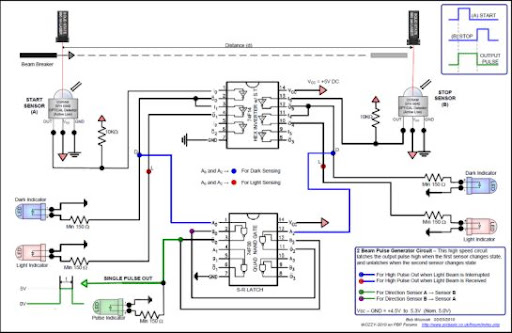Greetings,
I developed this pulse generator to create an Optical High Resolution Timer and Speed Measuring device. It uses two laser beams as gates.
2-BEAM OPTICAL PULSE GENERATOR
(download high resolution PDF file below)
I've been having a great deal of fun with it and thought I'd share it with you all.
I have no way of measuring the optical lag, however the circuit itself is quite fast and produces a clean output signal. Any optical lag should cancel, as the start and stop signals are treated the same way. Here's a scope shot that shows the response.
It takes two individual OSRAM optical sensor outputs and produces a single pulse that rises on the rising edge of the start sensor, and falls on the rising edge of the stop sensor. The OSRAM sensors are very nice, they are sensitive to all optical wavelengths and have a built in Schmitt trigger.
This circuit which uses a Set-Reset Latch built from feeding back two NAND gates on the 74F00. This allows me to bring the signal into a single PIC pin. I then can use timer-1 to determine the pulse width. Here's an image of the prototype circuit:
Anyway, I've learned so much from this forum that I thought It was time to reciprocate a little. Please feel free to comment on the circuit design, as I'm always learning.
The rest of the project is going pretty well, and now I'm down to just a few tweaks to optimize the code to allow for error corrections and to maximize precision. (I'll post the full code and PIC portion of this project soon)
Thanks to all the great educators, patient teachers and generally really smart folks on PBP Forums.
Bob












Bookmarks